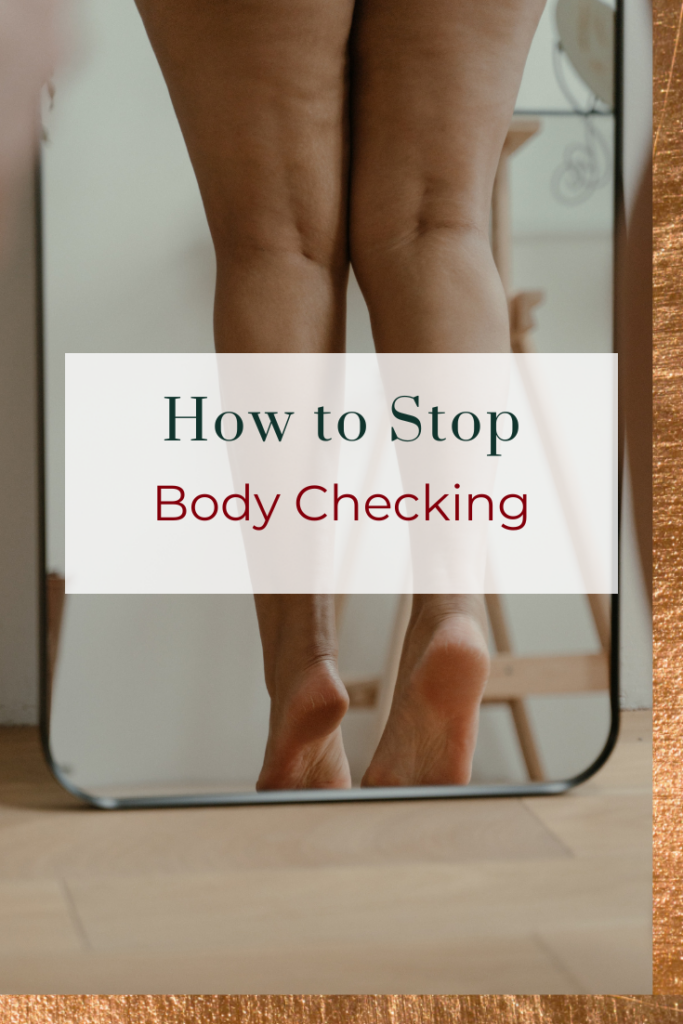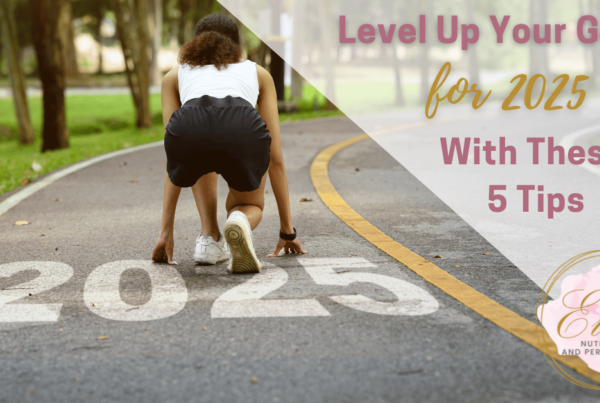Body checking – the compulsively scrutinizing, monitoring, and/or tracking of your body’s weight, size, or shape – can make it really difficult to move away from diet culture, listen to your body, and recover from disordered eating or an eating disorder. Read on to learn how to stop body checking, including 3 steps to reduce body checking behaviors.
What is Body Checking?
Body-checking is the compulsively scrutinizing, monitoring, and/or tracking of your body’s weight, size, or shape. There are many ways that people body check. Some people obsessively weigh themselves on a scale while others may have a certain pair of pants that they regularly try on to “check” and see how they fit.
Often people have a specific part of their bodies that they focus on when body checking. For example, one of my clients would pinch her stomach, run her hands over her belly, and whenever she would pass a reflective surface like a mirror or store window, her eyes would immediately go to her midsection.
Other people may fixate on their legs, arms, nose, forehead, or any other body part that they have been led to believe is “wrong” in some way.
Many times body checking is done subconsciously throughout the day and has become such a habit that often people don’t realize they’re doing it. These behaviors can range in severity and impact – sometimes the check is more mild, like stepping on a scale every few weeks.
Other times it is more debilitating, to the point where someone’s mind is almost constantly thinking about their perceived “flaw” and/or what they can do to “fix” it – often going to extremes with dieting and restriction or exercise to try and do so.
Forms of Body Checking Can Include:
- Frequently weighing yourself on the scale.
- Trying on a specific pair of pants or another clothing item to see how it fits.
- Feeling areas of your body, like your stomach or thighs or arms, to see if they’ve changed.
- Pinching or grabbing your skin.
- Measuring parts of your body with a measuring tap.
- Checking your reflection in mirrors, windows, or other reflective surfaces.
- Taking photos of yourself and/or specific body parts to “check” to make sure they haven’t changed.
- Obsessing about past or current photos of yourself.
- Asking other people for reassurance about how you look.
- Comparing your body to other people’s bodies.
- Comparing yourself to images you see on social media or online.
Body Comparisons
While the urge for comparison is an innate human characteristic, for many people it can cause a lot of harm and contribute to or worsen disordered eating and eating disorder behavior. While some comparisons can be healthy and helpful, people who frequently compare themselves to others have lower self-esteem, are more self-conscious, and have higher rates of anxiety and depression.
Social media has made this so much worse. While we used to only be able to compare ourselves to people we saw in our day-to-day life, now with just one click on our phones, we have access to images of millions of people around the world.
The vast majority of people in the mainstream media and with large followings on social media are young, thin, white, and “traditionally” beautiful. Yet in the real world, fewer than 5% of people actually look like this, and even among those who are considered “traditionally beautiful,” Photoshop is pervasive and commonplace.
Almost all of the images we see on social media, as well as on television or in magazines and advertisements, are edited to make the person’s body fit into the “perfect” aesthetic that we are used to. There’s also widespread use of minimally invasive plastic surgery, like Botox and fillers, among the people in those photos.
What we are exposed to on social media can make this beauty and body ideal seem real, normal, and attainable; however, the standards that these images uphold are anything but.
Why Do People Body Check?
For many people, body checking often starts as a way to “check” and see how they are “doing” – a way to measure themselves and make sure they are “on track”. Often this desire to be “on track” is related to a person’s value and worth being closely linked to how they look and/or the size of their body.
Many people will body check in an attempt to feel better about their bodies and to feel more in control. Oftentimes, people may think that body checking will help to decrease any anxiety that they are feeling. Yet in reality, it has the opposite effect.
Why is Body Checking Harmful?
When we don’t receive the feedback we want from body checking, anxiety, fear, and shame come rushing in. Often this happens when the information we’ve gathered from body checking has reinforced the belief that our bodies are a problem or that something is wrong with us.
While you may be body checking to feel better, to feel in control, or in an attempt to feel less anxiety, that’s often not what people receive. The reassurance that body checking behaviors give us typically only lasts for a short while (if at all), and then we experience an increase in negative emotions like fear, anxiety, and shame.
Our (natural, human) desire to want to get rid of those feelings often translates into needing to “fix” our bodies. For many people, this then causes or worsens restrictive eating behaviors and/or over-exercising.
The Link Between Body Checking and Disordered Eating
Trying to control something, like the amount or type of food you eat and/or your body size, can provide a false sense of security. Body checking does the same: often it comes from a place of wanting to control your body (and/or other things). This sense of control can, in the moment, make you feel more stable and safe.
Neuroscience explains this phenomenon:
Our brains are wired to keep us safe. Each time you go through some type of “threat,” your brain is wired to remember that threat and – the next time it arises – old thought patterns and behaviors emerge as coping mechanisms.
This means that in response to stress or anxiety — body checking fits in here — negative body thoughts can arise, and the urge to perform restrictive dieting behaviors, whether through food restriction or exercising, increases. Therefore, dieting (a form of disordered eating) and eating disorder behaviors can be a way to feel safe and in control, while it distracts from the other, more overwhelming emotions that may feel hard to deal with.
Body checking and body comparisons can also serve to pull you outside of your own body and make it difficult to listen to your body cues.
For example, take my former client Krysten (name has been changed to protect her privacy), who struggled with body-checking her stomach. She would study herself in the mirror, measure her waist, and physically pinch and manipulate the fat on her abdomen. Whenever she would walk by a window or other reflective surface, her eyes would immediately go to her midsection.
All these body-checking behaviors triggered her inner critic voice, which would say, “You are so disgusting,” or, “Look at all your gross rolls; you need to get it together.” When Krysten and I began working together, she was able to make huge strides in reconnecting with her body cues and listening to her body, yet one glance in the mirror would send her spiraling. She’d disconnect her from her inner wisdom and feel pulled back toward external rules and restrictions to “get it together.”
Does any of this sound familiar? Keep reading to learn more on how to lessen – and eventually stop – body checking behaviors.
How to Stop Body Checking Behaviors
Body checking develops over time, which means that it will also take time for it to lessen and stop. Give yourself some grace, and work on practicing the three steps below.
Note: when you’re working on reducing body checking behaviors, it can be really helpful to have the support of a trained professional.
Step 1: Raise Awareness
You can begin to reduce body-checking by raising awareness of your body-checking behavior. What strategies are you using to body check? When does it happen? How often are you doing it?
Make a list of all the methods you use for body-checking, whether that’s weighing, measuring, trying on clothes, looking in mirrors, or physically manipulating your body.
Even if you’ve gotten rid of your scale, you may still be keeping tabs on your body’s shape in subtle, sneaky ways. Notice all of the different ways that you take part in body-checking.
Step 2: Get Curious
Once you are more aware of when your body checking is occurring, start to get curious.
Reflect on the following questions:
- Why do you feel the need to body check?
- Are there certain situations, thoughts, or feelings that cause you to do more body-checking?
- How do you feel after body-checking?
- How does body-checking affect your ability to respect your body?
- When you have the urge to body check, what might it be that you really need?
Step 3: Develop Strategies to Reduce Body Checking Behaviors
Once you’ve raised awareness of your body-checking behaviors, work on resisting the urge to body check. A few ideas:
- In the short term, it may help to hide the scale, cover mirrors, and wear looser clothing so you are less inclined to body check.
- Develop a variety of coping tools that you can use when you feel sad, anxious, afraid, etc.
- When you feel the urge to perform a body checking behavior, ask yourself “What do I need right now?” Then pull out your list of coping tools and use one of those instead.
Over time, as you raise awareness and challenge your body-checking behaviors more and more, the urges will become less and less frequent. By body-checking less often, you will create more space to be able to connect with and listen to your body cues, treat your body with kindness and respect, and eat in a way that is nourishing.
Other Tips to Reduce Body Checking
- Be a conscious consumer. Think about the media you watch, read, and look at — pay attention to who is featured: Does everyone look similar, or is there diversity? If there are fat people, people with disabilities, or people of color, how are those characters portrayed?
- Do a social media cleanout. Unfollow accounts that do any of the following:
- Make you feel bad about yourself or your body in any way.
- Trigger comparisons.
- Feature extreme exercise or dieting behaviors.
- Share before and after photos.
- Promote a certain way of eating and/or cutting out certain foods or food groups.
- Feature primarily images of thin bodies.
- Diversify the media you consume. Follow social media accounts that feature a diverse range of body shapes and sizes. By following people of all different shapes, sizes, genders, abilities, and colors, you widen the definition of what a “normal” body is. The more you see images of people that feature fat bodies, hairy bodies, saggy bodies, bodies with stretch marks and acne, belly rolls and cellulite, the more you begin to realize that all this is normal. We are all normal.
Looking for more support?
Schedule a call to chat with our dietitians to learn more about how we can support you and your relationship to food and your body.








